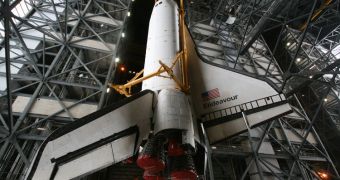A couple of days ago, the engineers with the American space agency hoisted the shuttle Endeavor into its other components, the external fuel tank (EFT) and the twin solid rocket boosters (SRB). This was done in anticipation to the orbiter's final launch.
The spacecraft is due to take off for the last time on April 19, from the Launch Pad 39A facility at the NASA Kennedy Space Center (KSC), in Florida. Mission controllers have decided to roll it out to the launch site today.
At this point, the orbiter is still in the KSC Vehicle Assembly Building, a 52-story structure that enables engineering crews to manipulate the shuttles via a complex system of cranes and pulleys.
During the “Lift and Mate” procedure, which precedes every rollout maneuver, the spacecraft was hoisted up on a number of cranes, and then carried out a mechanical ballet through the building.
At the end of the 36-hour process, Endeavor was attached to its external fuel tank and rocket boosters, atop of the mobile launch platform, Universe Today reports.
With this stage of the process complete, the shuttle and its components are finally ready to be taken out to the launch pad. NASA officials announce that the maneuver will begin today, and that it will last a little more than 6 hours.
The process will be just after the shuttle Discovery lands, which is also scheduled to happen today. The spacecraft is returning from the STS-133 mission to the International Space Station (ISS), and this is the last time it will ever fly.
After the orbiter touches down safely, NASA will begin to roll out Endeavor. The space agency has a habit of moving its shuttles to their launch pad a month or more in advance of the actual launch.
But some KSC officials believe that the retirement of these amazing vehicles is premature. “The orbiter has a lot of life left in her. The shuttle could fly many more missions,” explained a top shuttle manager.
Endeavor only flew 24 missions until today, 25 if we count STS-134. The spacecraft is still in good condition, and many believe that it could continue flying to the ISS for several years to come.
During its final flight, Endeavor will carry the Alpha Magnetic Spectrometer (AMS) particle detector to space. Valued at $2 billion, this is the most expensive experiment ever flown to the orbital facility.
Once it returns home, the shuttle will be decommissioned and then exhibited in a museum.
The last Space Shuttle Program mission ever will be flown by Atlantis in June, and it will serve as a resupply flight for the ISS as well.

 14 DAY TRIAL //
14 DAY TRIAL //